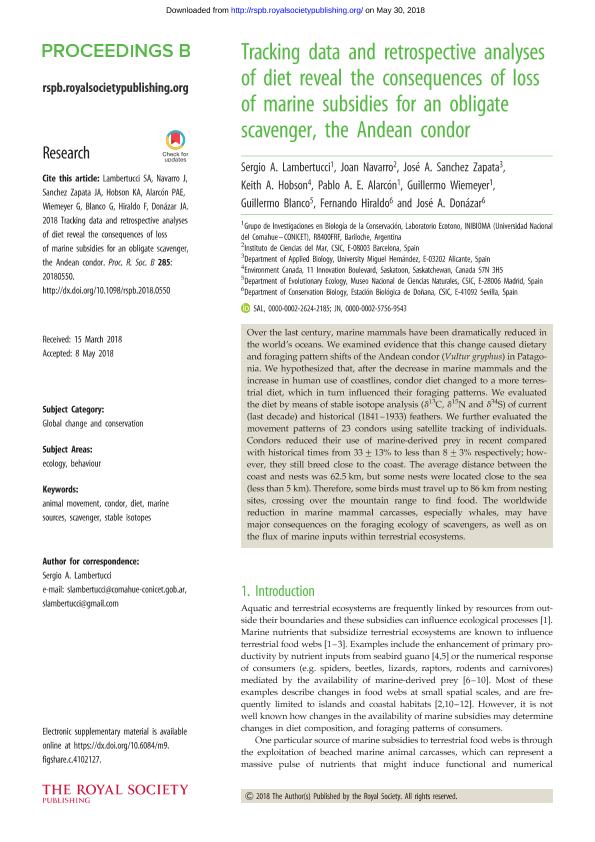Mostrar el registro sencillo del ítem
dc.contributor.author
Lambertucci, Sergio Agustin

dc.contributor.author
Navarro, Joan
dc.contributor.author
Sanchez Zapata, José A.
dc.contributor.author
Hobson, Keith A.
dc.contributor.author
Alarcón, Pablo Angel Eduardo

dc.contributor.author
Wiemeyer, Guillermo

dc.contributor.author
Blanco, Guillermo
dc.contributor.author
Hiraldo, Fernando

dc.contributor.author
Donázar, José A.
dc.date.available
2019-11-26T21:27:10Z
dc.date.issued
2018-05-30
dc.identifier.citation
Lambertucci, Sergio Agustin; Navarro, Joan; Sanchez Zapata, José A.; Hobson, Keith A.; Alarcón, Pablo Angel Eduardo; et al.; Tracking data and retrospective analyses of diet reveal the consequences of loss of marine subsidies for an obligate scavenger, the andean condor; The Royal Society; Proceedings of the Royal Society of London. Series B: Biological Sciences; 285; 1879; 30-5-2018; 1-7
dc.identifier.issn
0962-8452
dc.identifier.uri
http://hdl.handle.net/11336/90600
dc.description.abstract
Over the last century, marine mammals have been dramatically reduced in the world’s oceans. We examined evidence that this change caused dietary and foraging pattern shifts of the Andean condor (Vultur gryphus) in Patagonia. We hypothesized that, after the decrease in marine mammals and the increase in human use of coastlines, condor diet changed to a more terrestrial diet, which in turn influenced their foraging patterns. We evaluated the diet by means of stable isotope analysis (δ13C, δ15N and δ34S) of current (last decade) and historical (1841–1933) feathers. We further evaluated the movement patterns of 23 condors using satellite tracking of individuals. Condors reduced their use of marine-derived prey in recent compared with historical times from 33+13% to less than 8+3% respectively; however, they still breed close to the coast. The average distance between the coast and nests was 62.5 km, but some nests were located close to the sea (less than 5 km). Therefore, some birds must travel up to 86 km from nesting sites, crossing over the mountain range to find food. The worldwide reduction in marine mammal carcasses, especially whales, may have major consequences on the foraging ecology of scavengers, as well as on the flux of marine inputs within terrestrial ecosystems.
dc.format
application/pdf
dc.language.iso
eng
dc.publisher
The Royal Society

dc.rights
info:eu-repo/semantics/openAccess
dc.rights.uri
https://creativecommons.org/licenses/by-nc-sa/2.5/ar/
dc.subject
ANIMAL MOVEMENT
dc.subject
CONDOR
dc.subject
DIET
dc.subject
MARINE SOURCES
dc.subject
SCAVENGER
dc.subject
STABLE ISOTOPES
dc.subject.classification
Ecología

dc.subject.classification
Ciencias Biológicas

dc.subject.classification
CIENCIAS NATURALES Y EXACTAS

dc.title
Tracking data and retrospective analyses of diet reveal the consequences of loss of marine subsidies for an obligate scavenger, the andean condor
dc.type
info:eu-repo/semantics/article
dc.type
info:ar-repo/semantics/artículo
dc.type
info:eu-repo/semantics/publishedVersion
dc.date.updated
2019-10-10T13:54:39Z
dc.identifier.eissn
1471-2954
dc.journal.volume
285
dc.journal.number
1879
dc.journal.pagination
1-7
dc.journal.pais
Reino Unido

dc.journal.ciudad
Londres
dc.description.fil
Fil: Lambertucci, Sergio Agustin. Consejo Nacional de Investigaciones Científicas y Técnicas. Centro Científico Tecnológico Conicet - Patagonia Norte. Instituto de Investigaciones en Biodiversidad y Medioambiente. Universidad Nacional del Comahue. Centro Regional Universidad Bariloche. Instituto de Investigaciones en Biodiversidad y Medioambiente; Argentina. Universidad Nacional del Comahue. Centro Regional Universitario Bariloche. Laboratorio de Ecotono; Argentina
dc.description.fil
Fil: Navarro, Joan. Consejo Superior de Investigaciones Científicas. Instituto de Ciencias del Mar; España
dc.description.fil
Fil: Sanchez Zapata, José A.. Universidad de Miguel Hernández; España
dc.description.fil
Fil: Hobson, Keith A.. Environment Canada; Canadá
dc.description.fil
Fil: Alarcón, Pablo Angel Eduardo. Consejo Nacional de Investigaciones Científicas y Técnicas. Centro Científico Tecnológico Conicet - Patagonia Norte. Instituto de Investigaciones en Biodiversidad y Medioambiente. Universidad Nacional del Comahue. Centro Regional Universidad Bariloche. Instituto de Investigaciones en Biodiversidad y Medioambiente; Argentina. Universidad Nacional del Comahue. Centro Regional Universitario Bariloche. Laboratorio de Ecotono; Argentina
dc.description.fil
Fil: Wiemeyer, Guillermo. Consejo Nacional de Investigaciones Científicas y Técnicas. Centro Científico Tecnológico Conicet - Patagonia Norte. Instituto de Investigaciones en Biodiversidad y Medioambiente. Universidad Nacional del Comahue. Centro Regional Universidad Bariloche. Instituto de Investigaciones en Biodiversidad y Medioambiente; Argentina. Universidad Nacional del Comahue. Centro Regional Universitario Bariloche. Laboratorio de Ecotono; Argentina
dc.description.fil
Fil: Blanco, Guillermo. Consejo Superior de Investigaciones Científicas; España
dc.description.fil
Fil: Hiraldo, Fernando. Consejo Superior de Investigaciones Científicas. Estación Biológica de Doñana; España
dc.description.fil
Fil: Donázar, José A.. Consejo Superior de Investigaciones Científicas. Estación Biológica de Doñana; España
dc.journal.title
Proceedings of the Royal Society of London. Series B: Biological Sciences

dc.relation.alternativeid
info:eu-repo/semantics/altIdentifier/url/http://rspb.royalsocietypublishing.org/content/285/1879/20180550
dc.relation.alternativeid
info:eu-repo/semantics/altIdentifier/doi/http://dx.doi.org/10.1098/rspb.2018.0550
Archivos asociados
